Want an electric conversion? Be prepared to pay big money

About five years ago, I wrote a piece for Hagerty defending vintage car ownership. In it, I said that, on the surface, owning multiple vintage cars may seem as irresponsible as former first lady of Philippines Imelda Marcos owning thousands of pairs of shoes and hundreds of fur coats, but I defended myself and like-minded car nuts by arguing that, from an environmental standpoint, lightly driven vintage cars have a very small carbon footprint. I joked that my 1974 Lotus Europa, having been dead for 40 years, still owes the world a few decades of carbon.
Not long after, I began seeing articles about electric conversions of classic vehicles. There were press releases from both Aston Martin and Jaguar saying—in response to some European cities proposing the closure of their downtown sections to internal combustion vehicles—that they were offering well-heeled clients factory electric conversion of their precious E Types and DBwhatevers. Reading further, this allowed for cost-sharing of the new electric platforms being developed for Jaguar’s I-Pace crossover and Aston Martin’s Rapide E, so the motives were perhaps not as bright green as they seemed.
Aston Martin’s release really caught both my eye and my ridicule, as it referred to its electric conversion as a “cassette,” with the implication that it could be easily slid in and out. “The cassette system offers the perfect solution, offering owners the reassurance of knowing their car is future-proofed and socially responsible, yet still an authentic Aston Martin, with the ability to reinstate its original powertrain if desired.
OK. Well. First, “future-proofed?” Really? Is it going to automatically encase itself in carbonite like Han Solo when sea levels rise or if an asteroid pulverizes the planet?

Second, knowing nothing about electric conversion but a little about engine swaps, the idea that every aspect of a gas-to-electric conversion can be encased in a “cassette” may be good public relations, but it is of dubious engineering merit.
You might infer from this that I’m anti-EV. Not true. I think that electric vehicles, when recharged with power generated by renewable energy sources (e.g. solar and wind) are part of a necessary response to climate change. But I am resolutely anti-hyperbole.
Since then, the electric conversion of classic vehicles, or at least the aggressive marketing of it, appears to have only increased. Nowadays, it seems that you can’t throw a bad condenser without hitting a laptop displaying an article about electrifying classic cars. Shops performing conversion work appear to be springing up in many American cities. Some are single-marque or single-theme, while others are equal opportunity converters.
Normally I wouldn’t pay any of this much mind, but an electric-converted 1974 BMW 2002 recently went up for auction on Bring a Trailer. As I’ve owned 40 of these little German sedans and still own three of them, I couldn’t help having some academic interest. Plus, there’s the odd bit of historical trivia that BMW actually built two electric 2002s that were used during the 1972 Munich Olympics. With 12 Varta lead acid batteries under the hood, the cars had a range of 37 miles at a constant 31 mph. Fortunately, EV technology has advanced over the last 50 years.

The work on the BaT 2002 was performed by a shop in Austin, Texas, that has received favorable press. The company’s website and videos show converted high-dollar classics like an E Type, a long-hood 911, and an Alfa GT Veloce. The company owner and his engineers exude passion for the work and respect for the art form that is a vintage car, and they reason that electric conversion a) makes a car environmentally palatable, b) increases performance, and c) solves the problem of the unreliability of a 50-year-old internal combustion vehicle. If I can nitpick about that last point, in one video, one of the engineers perhaps drank from Aston Martin’s fountain, as he strays from passion to hyperbolae and says that classic cars “are fickle finicky vehicles, but when it’s [sic] run by a massive battery and an electric motor, it’s basically as reliable as a microwave oven.”
I’ve written multiple articles about what I refer to as “The Big Seven” things likely to strand a vintage car. They are ignition, fuel delivery, cooling, charging, belts, clutch hydraulics, and ball joints. I fully agree that if you replace an internal combustion engine and its cooling and charging systems with a modern electric system, you eliminate the first five of these, and that’s nothing to sneeze at. But you still have a classic vehicle with its attendant electrical quirks (funny, right?), old brakes, steering, and suspension, and now you’re adding in the range and “who repairs it?” issues of a one-off electric conversion whose battery capacity is unlike to be that of a ground-up design.
But even assuming there’s a step increase in reliability, there’s a huge overriding issue with these conversions. And it’s not the whole “you’re destroying a classic” argument. As far as I’m concerned, it’s your car—go to town and paint flaming purple Smurfs on the hood if you like. In the case of the BaT vehicle, a BMW 2002 is a common model. There are a lot of them. It’s not like someone is electrifying James Bond’s DB5 (and, even if they were, if you believe Aston Martin, you could always just hit the eject button and swap back in the internal combustion “cassette”).
Nor is it the “you’re destroying the classic’s soul” argument. There’s a whole continuum of paths for ownership of a classic car, from keeping it bone stock, to light modifications for drivability and reliability, to hot-rodded, to wild engine swaps, to turning it into track-only vehicle or a race car. Electrification is somewhere on the right edge of this curve.
Personally, I think if you want a newer, quieter, more-powerful car, you should just buy a newer, quieter, more-powerful car and stop trying to turn your classic into something it isn’t. But to single out electric conversion and point at it—Invasion-Of-The-Bodysnatchers-style—as an affront against man, and God, is silly. That being said, I do have some “soul” concerns. I’ve experienced how even mild modifications such as a stiffer suspension or a five-speed retrofit can change the car in unintended ways, affecting the way it sounds, feels, and vibrates. The relationships we have with our beloved cars are intimate things, and changes in a car’s vibe can affect our connection with it. Even over and above electrification’s obvious “no more gas, oil, and exhaust fumes” and “no more WAAAAAAAAAA-waaaaaaa when you wind it out” issues, I do wonder about the degree to which removing some of a car’s grit and rasp and replacing it with an antiseptic Stepford-wife, golf-cart whine may stress or break the owner-vehicle bond.
But the issue, the thing I’d like to see addressed in the first sentence of every article about electric conversion, is the high cost. The website of the company that converted the BMW 2002 on BaT estimates conversion cost at $50K–$150K, depending on the vehicle’s make and model, the need for general non-electric-conversion restoration work, the desired level of performance, and other factors.
Holy electrons, Batman. You’d have to leak a lot of gas, oil, and antifreeze to approach that.
It made me wonder who spends this kind of money. One of the company’s videos talks about people who “want the ability to appreciate that art form, but they want… a sense that they’re doing it with less impact to our planet” and “want the seamlessness of not worrying, just driving.” That’s great PR, but to me that price tag instantly makes this kind of conversion the province of folks with summer homes in the Hamptons.
My ever-reasonable wife asked me, “How does that compare with the cost of a new EV? Couldn’t a buyer be someone who simply wants a cool vintage electric-converted car to use as a daily driver?” Left-brained me answered that vintage vehicles and daily drivers are usually two different things, and that only a died-in-the-wool car person would likely put up with the wind and road noise, primitive suspension, reliability, and safety issues of a classic car, electrified or not, to try to daily it for anything other than trivially short commutes.
Let’s look at the specifics of the electric-converted 1974 BMW 2002 on BaT. What the car had going for it was that it was converted by a known company, the photos of the converted portions appeared to show excellent work, the car was painted the highly desirable color of Colorado (pale orange), and although it began life as a big-bumpered square tail light 2002, it had received a small-bumper conversion.
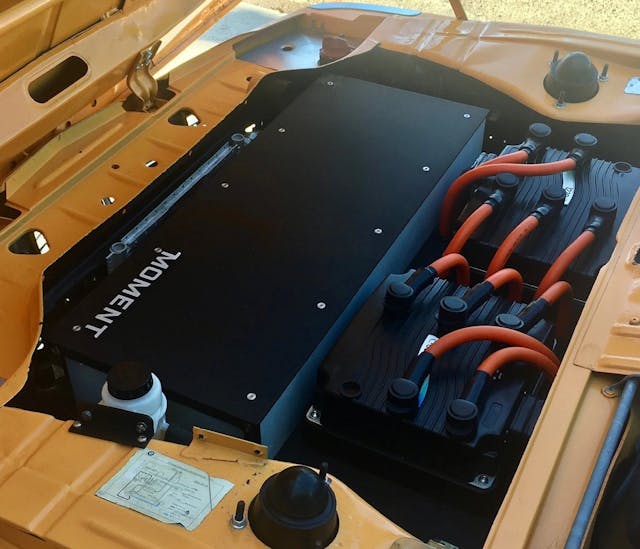
In addition, part of the converter’s design philosophy is to maintain the manual transmission and clutch, as that keeps the car fun to drive, and it doesn’t interfere with the look and feel of the gearshift lever. This car actually had a five-speed in it, which was pretty cool.
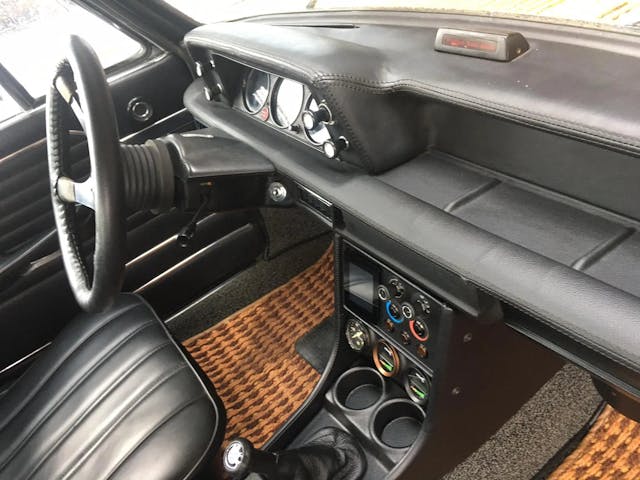
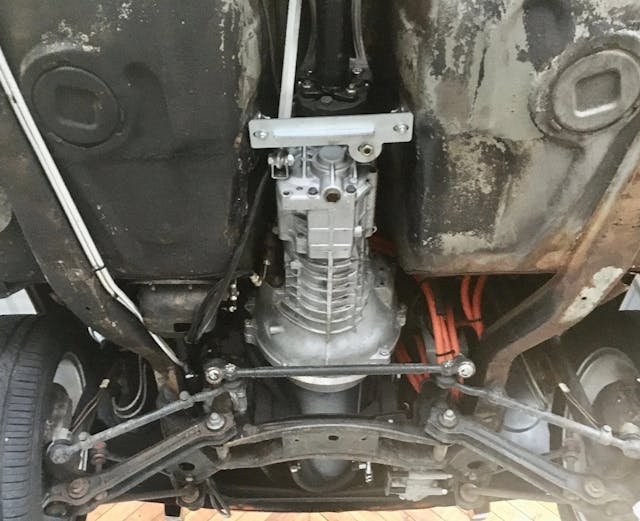
But there were some negatives. The rectangular holes for the original front bumpers’ hydraulic cylinders hadn’t been covered up; the car had been shaved (de-trimmed); it had air conditioning via a modern climate control box, whose vents were occupying the places in the dashboard where the original vent sliders were; and the dash had a stitched leather cover. OK, perhaps only the big bumper holes are a demerit, but while there’s nothing cringe-worthy with any of the other issues, there’s no denying that they collectively moved the car away from a bone-stock configuration. I’d think that from a value standpoint, a blue-chip electric-converted 2002 would be a flawless 1968–73 round-taillight car that looked absolutely stock until the hood was opened. This wasn’t that.
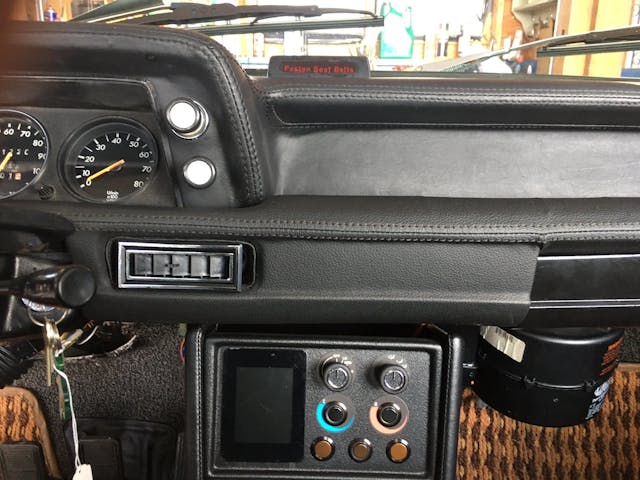

Plus, as pretty as the car’s exterior was, it had not had a rotisserie-style restoration, so the floor pans and subframes showed the small amounts of oxidation that every unrestored car has. Nothing wrong with that; every car I own looks likes this underneath. I imagined that the owner thought of the car as being in the Goldilocks zone for an electric conversion. That is, if it was too rare, too original, or too mint, you might not want to modify it, whereas if it was too beat-up or rusty, it wouldn’t be worth the expense and effort.
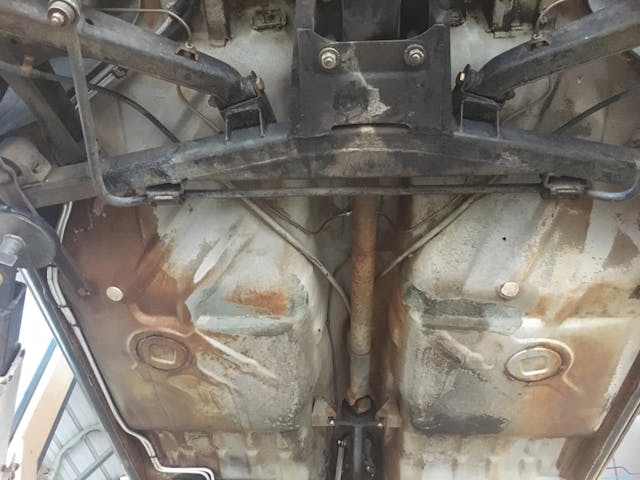
However, as I wrote when I tried to sell my 49,000-mile survivor 2002, what’s valued on BaT and causes bidding wars to head for the stratosphere are cars that present themselves in such a way that potential well-moneyed buyers think they’re bidding on a completed fully-executed whole that needs nothing. The contrast of a car’s freshly painted exterior with an original undercarriage conveys the image that the car is unfinished and holds the price on BaT down for any car. This was no exception.
The kicker was that although the car had a standard J1772 charging connector, and the conversion included a nifty adaptation of the stock gas gauge to display the reserve charge, the seller quoted the car’s range as only about a hundred miles. Gee, maybe things haven’t progressed as far as I would’ve thought since the 1972 Olympics.
Together, all these things added up to caveats that caused the bidding to top out at $42,500. Given the cost estimates listed on the conversion company’s website, I can’t imagine that the sale price wasn’t substantially less than the seller had in it.
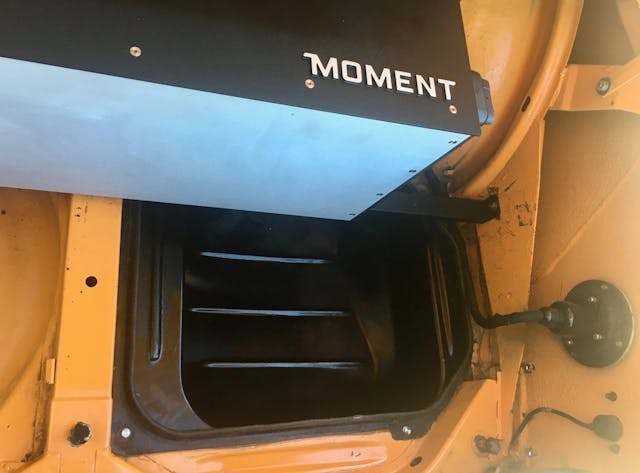
But still, $42,500 is a lot of money, at least it is to me, and that got me thinking.
As I say over and over, I am neither wealthy nor a collector. I own 13 vehicles (including a truck, little RV, and two daily drivers) because they’re either useful to me or they resonate with me in some way, but I struggle daily with both the financial and the storage repercussions. I see many cars locally on Craigslist and Facebook Marketplace that fall into what I think of as a “whim-able” price window. I used to regard this as four grand, in which all sorts of depreciated BMWs and running oddballs like Saab Sonnets, Fiat X1/9s, and ’63 Rambler 770s fall, but I’ve widened my view a bit to eight grand, as that also captures things like running but needy pre-1975 C3 Corvettes.
Still, in an environment of tightly-constrained money and space resources, the thought experiment I perform for any purchase—particularly one that’s outside my wheelhouse—is “What would I actually use the car for?” I know what I use the 1970s BMWs for. I road-trip the hell out of them. Yes, I also pleasure-drive them and use them to run errands—there’s nothing like taking a beloved classic to get milk on a Sunday morning to turn it into an event—but the road-trip part is in both my and the cars’ DNA. The Lotus Europa still hasn’t seen a big road trip, but I adore driving the featherweight little thing on twisty local roads. So, if the answer to the usage question is “I’d probably just drive it to cars and coffee a few times a year,” that’s a fail. I simply don’t have the space or the money to support owning something with that usage profile.
In truth, of course it’s less black and white than that. My 1999 BMW M Coupe (“the clown shoe”) is barely driven these days, and although my 49,000-mile 2002 did recently get a short road trip to Vermont, it’s more of an errand and a local events car. And some of my other ’70s BMWs haven’t seen a multi-day road trip in years.
But still, hypothetically, what would I actually use an electric 2002 (or any electrified classic whose range is only a hundred miles) for? That would seem to effectively rule out spirited day drives with my local 2002 pals. Yes, in theory, 30 minutes of a quick charger attached to the J1772 port should give an 80 percent charge, or another 80 miles, but that doesn’t feel like much. Me, I’d rather have the unconverted car with the range, the fumes, and the chunky rasp when I get on the throttle. And save the $42,500. Or the $50K–$150K, depending on how you want to look at it.
In my first book, there’s a chapter, titled “Restoration and why it makes no freaking sense,” in which I say that buying a car into which someone else has already sunk restoration money is almost always cheaper than spending the money yourself, but note how people pay to have cars restored anyway because it’s all about choice—what pops out at the end is the manifestation of all those choices, and so, naturally, you love it. I think that choosing to have a vintage vehicle electrified is a boutique subset of this larger restoration issue in that people who do it want to do it, probably because a) it fits their environmentally-friendly self-image, and b) they can afford it and the left-brain analytics probably don’t matter that much. I have no argument with that, but if you say that you’re doing it strictly for environmental reasons, and if your daily driver isn’t an EV, I think the justification is pretty thin. And if you say you’re doing it so you can still drive your beloved classic when gasoline is as controlled as ivory, okay, but you’re paying a very hefty premium to be on the bleeding edge. From this standpoint, the buyer of the electric 2002 on BaT made out very well.
So now I can tell you the surprising part: The BaT seller of the electric 2002 and the guy who paid to have the conversion work done was my old friend and BMW 2002 mentor from my days in Austin, Terry Sayther. Terry is 40-year member of the BMW Car Club of America, had a shop in Austin for decades, has forgotten more about 2002s than I’ll ever know, and has done a whole variety of engine swaps. In other words, the last thing he is is my hypothetical hedge-fund closet environmentalist EV-converted classic owner.
When I asked him why he did it, he said he wanted to experience an electric 2002 in the same way he wanted to experience a 2002 with a 240-horsepower S52 engine from an E36 M3 (which he also owns). He said that the electric 02 was very much a pleasure to drive, was a good city car (though more range would’ve been nice), was great to use on date nights with his wife, and, yes, did attract a lot of attention at cars and coffee events. So, you can ignore most everything I said.
Except the price tag.
If I’m still alive when gas really is akin to ivory, and the price of an electric conversion is comparable to that of an engine swap, I’ll likely change my tune (I’m above most things a practical man). Until then, you’ll recognize me because I’m the guy smiling as his car’s leaky fumy internal combustion engine is being wound out.
Really, I just want folks to be careful and realistic. The fact that an expensive boutique-converted electric BMW 2002 has only a hundred-mile range strikes me as a valuable illustration of where EV conversion technology is today and what is and isn’t reasonable to expect when you have to deal with the constraints of a vintage car. The time may come when electric conversion is the necessary and affordable way to keep driving your classic, but that time is certainly not today.
Oh, and that factory Jaguar electric E Type? Be careful what you wish for. This was the 2018 press photo of the dashboard in the prototype. If I ever owned an E Type, plunked down mortgage levels of money for electric conversion, and the interior came back looking like this, I’d want 10 minutes in a windowless room with the people who cashed my check.

***
Rob Siegel’s latest book, The Best of the Hack MechanicTM: 35 years of hacks, kluges, and assorted automotive mayhem, is available on Amazon. His other seven books are available here, or you can order personally inscribed copies through his website, www.robsiegel.com.


There are so many good engine conversions for the M10..Our shop in the day did quite a few including S14, M42,S38,as well as the 2 valve 3.0 and 3.5 and even one Schnitzer car…Electric anything for me is a step backwards…and ruins the true nature of what the car was all about…
Hey, Rick, good to hear from you. As I said in the piece, I’m less dogmatic about whether these cars “should” be converted. That’s an owner-by-owner decision. I’m just tired of reading glitzy pieces that present conversion in the same light as recycling your plastic, or at worst, doing an R134a conversion on a car that originally had R12.
“One of the company’s videos talks about people who ‘want the ability to appreciate that art form, but they want… a sense that they’re doing it with less impact to our planet.'”
Those people should spend a year mining cobalt for their EV battery cathodes with the child slaves of the Congo.
So should all the state and federal officials that are subsidizing every expensive aspect of forcing a switch to this particular “greener technology” that they are cramming down our throats along with their narratives that this is the best and only path to saving the planet. (They are making us pay for those folks to drive the expensive Teslas vs. a hybrid Prius) Don’t look behind that curtain as to where the electricity comes from or how the sausage is made!
Those rushing to new electric vehicles are not considering many factors:
– redirecting energy from oil industry to utility companies will place a very heavy and expensive burden on consumers.
– power grid already experienced shut downs now and the security of the nations power grid is already suspect.
– expanding the power grid system to meet demand will be passed onto the consumer.
– many domestic auto manufacturers goal for total/most EV vehicles replacement will be 2030.
– EV vehicles are still a luxury and will not be affordable for average user.
-What country(s) will provide raw materials? China, Bolivia, Argentina and Congo are among worlds largest deposits of lithium (battery)
-DO WE REALLY NEED to rely on CHINA Again as a supplier for critical (strategic) materials?
Those rushing to new electric vehicles are not considering many factors:
– redirecting energy from oil industry to utility companies will place a very heavy and expensive burden on consumers.
– power grid already experienced shut downs now and the security of the nations power grid is already suspect.
– expanding the power grid system to meet demand will be passed onto the consumer.
– many domestic auto manufacturers goal for total/most EV vehicles replacement will be 2030.
– EV vehicles are still a luxury and will not be affordable for average user.
-China, Bolivia, Argentina and Congo are among worlds largest deposits of lithium (battery)
-DO WE REALLY NEED to rely on CHINA Again as a supplier for critical (strategic) materials?
Those rushing to new electric vehicles may not consider these factors:
– redirecting energy from oil industry to utility companies will place a very heavy and expensive burden on consumers.
– power grid already experienced shut downs now and the security of the nations power grid is open to damage.
– expanding the power grid system to meet demand will be expensive to consumers.
– EV vehicles are still a luxury and will not be affordable for average user.
-China, Bolivia, Argentina and Congo are among worlds largest deposits of lithium (battery). DO WE REALLY NEED to rely on CHINA Again as a supplier for critical (strategic) materials?
You lost me with the climate change words.
There is a place in the hobby for all types. A person may want the old car look and feel but add technology. No different than putting a Ford flathead V8 in a Model T roadster or the Chevy 350 in a 32 Ford. If you have the money, do what you want with YOUR car. May not be my cup of tea. However, if the car is original and it is all there and in good shape, DON’T do any conversion, whether electric or LS V8 as the car is only original once.
A very well written article – a vintage vehicle is just that: a vintage vehicle. I can understand some updating or pro modding. To convert a vintage car ( or truck ) into an EV is a nice idea but from a practicality view, it is ridiculous. Seems to be just another way for those who have too much money to begin with, an avenue to show off their ability to waste money. Buy a classic, drive a classic, enjoy a classic as it was meant to be.
This was an article needing to be written for about 2 years now! I’ve become very tired of magazine types writing articles glorifying ev crap as the only way we’re going to move forward in the old car hobby. Yes, ev stuff has its place, but for the foreseeable future COST ALONE is going make ev vehicles not easily sold to the average car buyer. Hybrids right now are the ONLY kind of ev to buy. No range problems to worry about & you can tell yourself you might actually be doing something in a small way to help whatever you’re worried about with the planet
The base argument for electrification is completely bogus and is being sold to the Public as the Savior of The Universe! Even Rob talks about “sustainable/renewable energy sources”. Where do people think that these solar and wind apparata come from–they come from the use of even MORE fossil fuels–they must be manufactured by the use of some energy source–that source is fossil fuels! We are using MORE fossil fuels than ever to “fuel” (pardon the pun here) sustainable energy/fuel sources. The only manner for using less fossil fuels is to quit making vehicles for the general public–period (which actually is the goal of Agenda 21–2030, BTW). But, moving along–does anyone address the increased weight of an EV? This is going to affect suspension, shock equipment and tires–yes–even the tires–a heavier vehicle puts more stress upon all of these things. Just installing electric components does not nearly cover the eventual costs of conversion. But, let’s move along–how does the car’s newly acquired extra weight affect its registration weight category? But, that’s not the only change in the car’s status–how does electrification affect a collector vehicle’s Collector Car Insurability? For one of my collector cars, I was asked by Hagerty if the car was classically restored or modified. Hummmmm! So…even Hagerty recognizes a difference! There’s a LOT more to be said–NOT in favor of the “electrification craze”.
So thanks for the answer to this version of “What Price for Wokeness?”…the whole concept of taking a vintage vehicle and converting it to an EV is ridiculous to begin with – and now that we have a fix on the price for doing this, it makes it even more absurd!! Those who would choose to do this come under the “a fool and his money are soon parted” category – to be sure!!
You missed another major reason for an EV conversion: the spouse factor. I have one classic, a 1963 Austin Cooper, that I love and drive all the time. It’s loud and stinky and all the things that my wife hates. I have been pining for years for a classic VW Bus, but since our garage is connected to the house my wife insisted “no more stinky, carbureted cars!” I’m now the new owner of a 1965 VW 21-Window Bus and on a waiting list for an electric conversion with Zelectric. Yes, I am concerned about the environment, but the reality is that my classics aren’t being driven more than 1000-ish miles per year. I have no illusions that going from ICE to EV will suddenly make the Bus daily-driver material. But the EV conversion makes the difference between having a Bus and having zero Buses. It’s fantastically expensive, but—for me—this is a bucket-list car.
Stop !!!
I happen to live across the great pond in the Old World Here, in the Netherlands, we currently pay about 9$/gallon. (yes. We didn’t conquer Iraq) The EU has very strict laws coming for ICE (new builds will be banned in 2030), charging infrastructure is getting there and city centers (like Oslo) are banning access for combustion engines.
Lots of reasons to consider electric.
If you like the looks of an old car, the styling and design, it doesn’t matter how it is propelled.
A new EV just doesn’t look as pretty as your 50s Cadillac.
I hope you will realize a car designer in the 50s didn’t necessarily design his car to smell like fumes and oil, to vibrate and rumble and shake. Some of them were really aiming for a smooth and quiet ride. If they would have had the option for EV back in the days when designing a new Continental, I am pretty sure it would have been electric.
Off course I do like the dinosaur grunt of a big V8.
But as much as I enjoyed my 2000 BMW 750i, i can totally imagine the V12 being replaced by an AC motor and having the same smoothness of a ride.
But with the awesome looks, and not the ugliness of modern BMWs (iew)
I think we are converting the wrong classics.
Don’t convert a sports car. Aim for the luxury vehicles and people will understand.
Now if only all electricity was from non fossil fuels. But since it isn’t, the banning of internal combustion engines from cities is just virtue signalling.